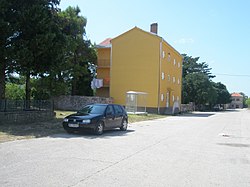Ervenik
Ervenik | |
|---|---|
| Općina Ervenik Општина Ервеник Municipality of Ervenik | |
 | |
 | |
| Coordinates: 44°06′28″N 15°56′24″E / 44.107684°N 15.939871°E | |
| Country | |
| Historical region | Dalmatian Hinterland |
| County | |
| Government | |
| • Mayor | Predrag Burza (SDSS) |
| Area | |
| 212.8 km2 (82.2 sq mi) | |
| • Urban | 91.3 km2 (35.3 sq mi) |
| Population (2021)[3] | |
| 789 | |
| • Density | 3.7/km2 (9.6/sq mi) |
| • Urban | 227 |
| • Urban density | 2.5/km2 (6.4/sq mi) |
| Time zone | UTC+1 (CET) |
| Website | ervenik |
Ervenik (Serbian Cyrillic: Ервеник)[1] is a village and municipality in Šibenik-Knin County, Croatia. There were 826 inhabitants (municipality) in 2021, and 97.19% of the population were Serbs, making Ervenik the municipality with the highest percentage of Serbs in Croatia. Population of the village was 243.[4]
History
In 1636 the village was settled by Roman Catholics (Croats), who after the Cretan War (1645–1669) would be reduced to 7 families by 1697, steadily replaced by Serb Orthodox population.[5] In 1928 and 1947 lived 79 and 47 Roman Catholic families respectively, but by 1987 were again reduced to only 7 families.[5]
Culture and monuments
There are two churches in the village:
- Catholic Church of St. Michael the Archangel outside the village (first mentioned in 1402).[6]
- Orthodox Church of St. Nicholas in the center of the village, according to Nikodim Milaš was built between 1669 and 1682, but by architectural characteristics is evidently that the Orthodox church was founded by renovation of a medieval Gothic Roman Catholic church.[6][7]
Also, in the vicinity of Mokro Polje (and Ervenik), there are remains of the aristocratic Keglević fort (Kegaljgrad), which was first mentioned in documents in 1433.
Settlements
The municipality of Ervenik includes 5 settlements:[8]
- Ervenik
- Mokro Polje
- Oton
- Pađene
- Radučić
Ervenik Municipality
| Population by census[9] | ||||||||||||||||
|---|---|---|---|---|---|---|---|---|---|---|---|---|---|---|---|---|
| 1857 | 1869 | 1880 | 1890 | 1900 | 1910 | 1921 | 1931 | 1948 | 1953 | 1961 | 1971 | 1981 | 1991 | 2001 | 2011 | 2021 |
| 4,874 | 5,222 | 5,224 | 5,835 | 6,511 | 7,059 | 6,518 | 7,331 | 6,848 | 6,945 | 6,694 | 5,710 | 4,836 | 4,115 | 988 | 1,105 | 826 |
Note: Formed from part of the pre-war municipality of Knin.
Ervenik (village)
| Population by census[9] | ||||||||||||||||
|---|---|---|---|---|---|---|---|---|---|---|---|---|---|---|---|---|
| 1857 | 1869 | 1880 | 1890 | 1900 | 1910 | 1921 | 1931 | 1948 | 1953 | 1961 | 1971 | 1981 | 1991 | 2001 | 2011 | 2021 |
| 2,080 | 2,129 | 2,123 | 2,337 | 2,466 | 2,788 | 2,467 | 2,829 | 2,318 | 2,331 | 2,397 | 2,056 | 1,827 | 1,570 | 227 | 287 | 243 |
Note: From 1857 until 1961 the village of Ervenik was listed as two separate inhabited places, Donji Ervenik and Gornji Ervenik. The population from those years is the sum of the two villages.
Notable people
References
- ^ a b Government of Croatia (October 2013). "Peto izvješće Republike Hrvatske o primjeni Europske povelje o regionalnim ili manjinskim jezicima" (PDF) (in Croatian). Council of Europe. p. 36. Retrieved 30 November 2016.
- ^ Register of spatial units of the State Geodetic Administration of the Republic of Croatia. Wikidata Q119585703.
- ^ "Population by Age and Sex, by Settlements" (xlsx). Census of Population, Households and Dwellings in 2021. Zagreb: Croatian Bureau of Statistics. 2022.
- ^ "Population by Age and Sex, by Settlements, 2011 Census: County of Šibenik-Knin". Census of Population, Households and Dwellings 2011. Zagreb: Croatian Bureau of Statistics. December 2012.
- ^ a b Bačić, Stanko (1998). Osvrt na knjigu "Pravoslavna Dalmacija" E. Nikodima Milaša [Critics of points of view of Nikodim Milaš in his book "Orthodox Dalmatia"] (in Croatian). Zadar: Matica hrvatska. pp. 290–292. ISBN 953-6419-19-X.
- ^ a b Škiljan, Filip (2008). "Problem srednjovjekovnih crkava koje su predane pravoslavnima" (PDF). Međunarodni znanstveni skup Srpsko-hrvatski odnosi u 20. veku: zbornik radova (in Croatian). Novi Sad: Centar za istoriju, demokratiju i pomirenje, Udruga za povijest, suradnju i pomirenje. p. 91–102. ISBN 978-86-86601-05-6. Retrieved 11 February 2025.
- ^ Škiljan, Filip (2008). "Problem srednjovjekovnih crkava koje su predane pravoslavnima" (PDF). Međunarodni znanstveni skup Srpsko-hrvatski odnosi u 20. veku: zbornik radova (in Croatian). Novi Sad: Centar za istoriju, demokratiju i pomirenje, Udruga za povijest, suradnju i pomirenje. p. 91–102. ISBN 978-86-86601-05-6. Retrieved 11 February 2025.
- ^ "Population by Age and Sex, by Settlements, 2011 Census: Ervenik". Census of Population, Households and Dwellings 2011. Zagreb: Croatian Bureau of Statistics. December 2012.
- ^ a b - Republika Hrvatska - Državni zavod za statistiku: Naselja i stanovništvo Republike Hrvatske 1857.-2001.


